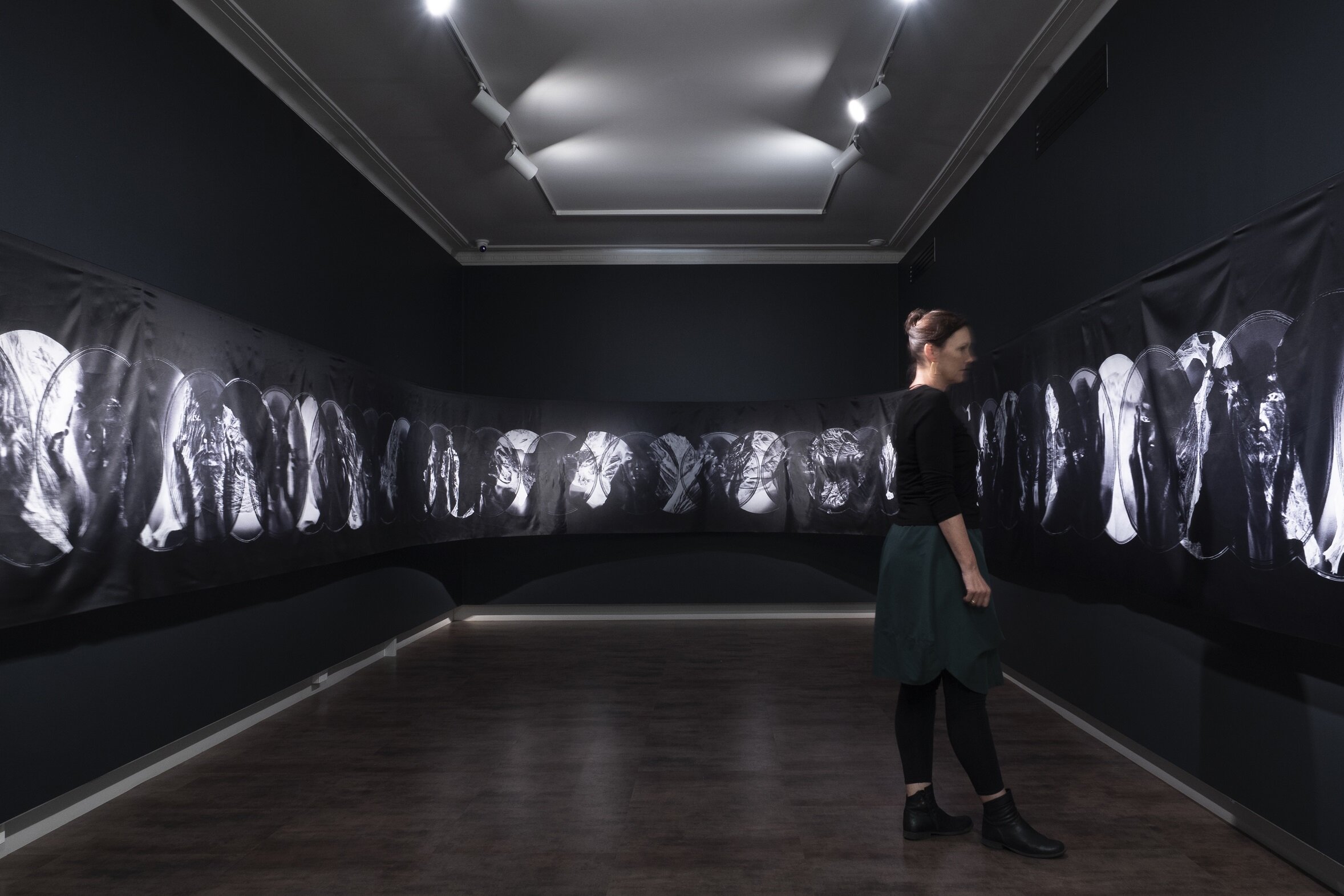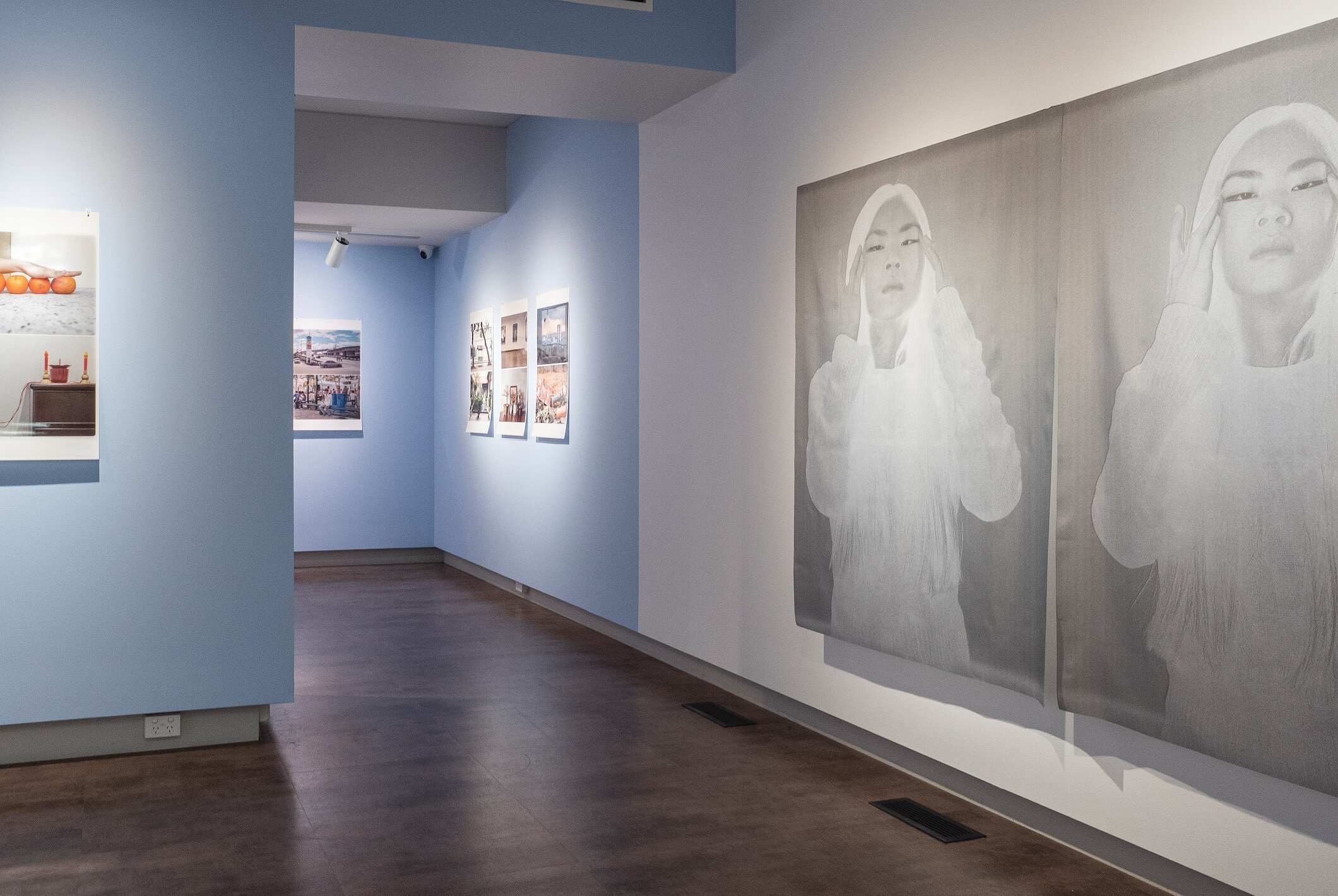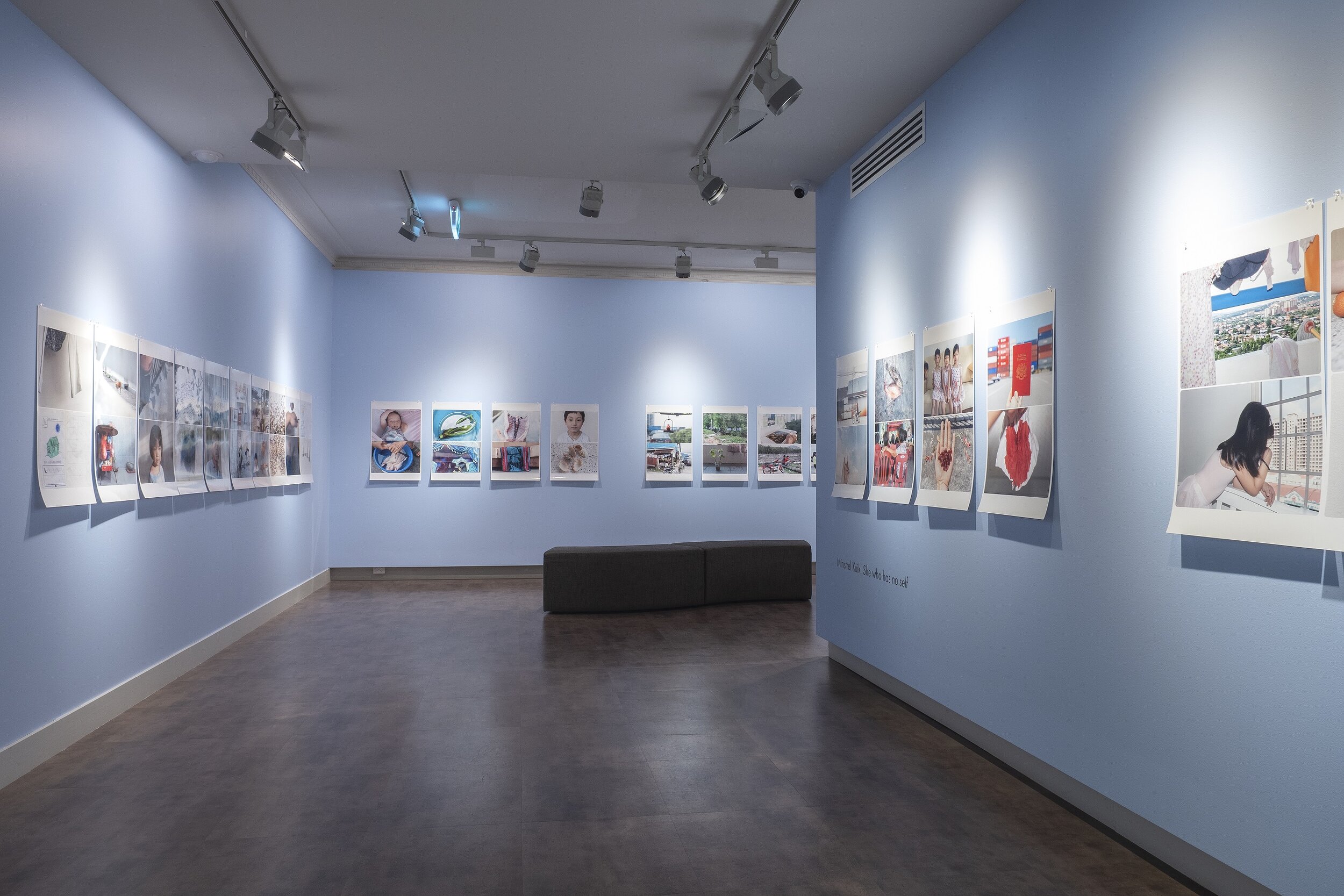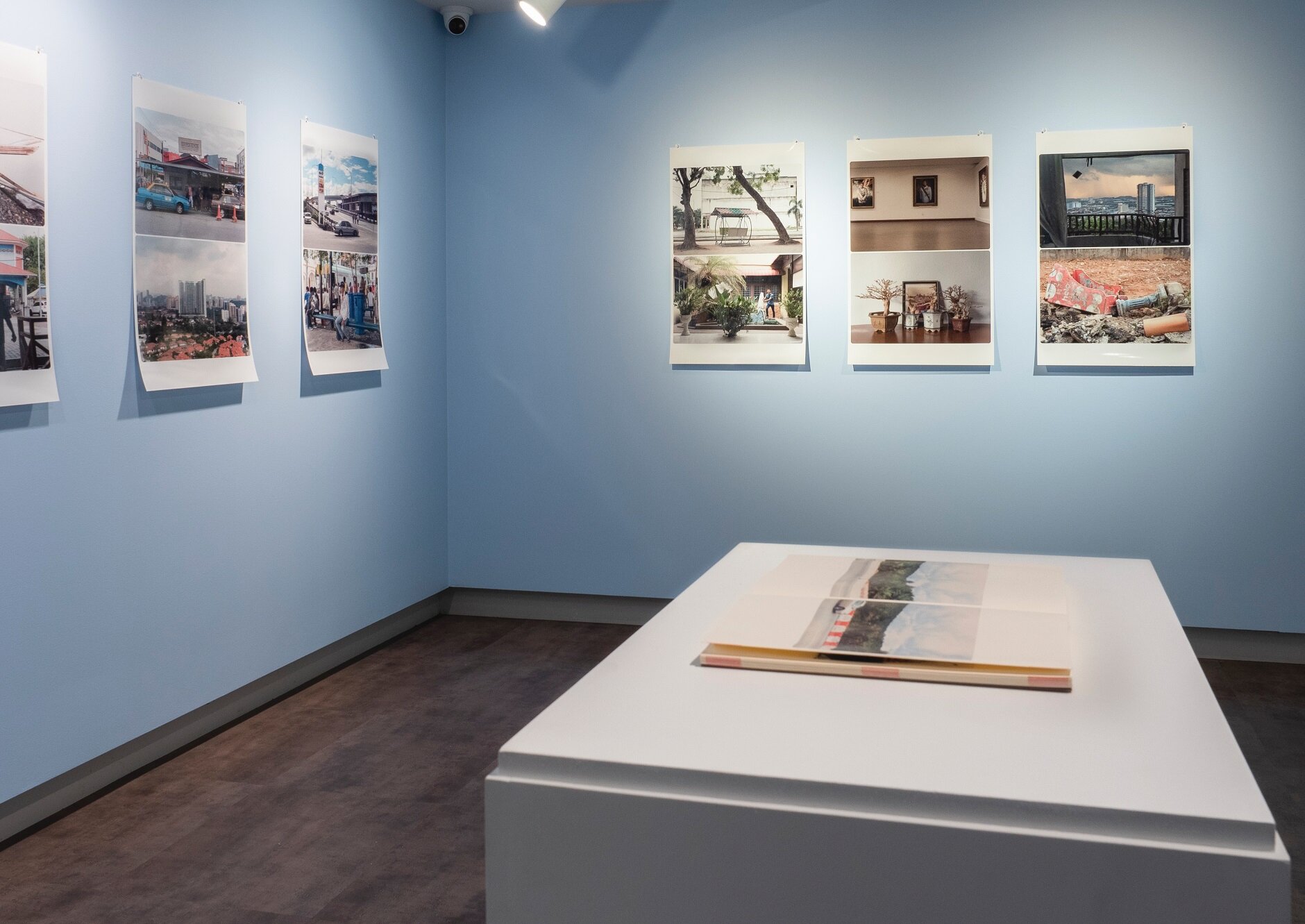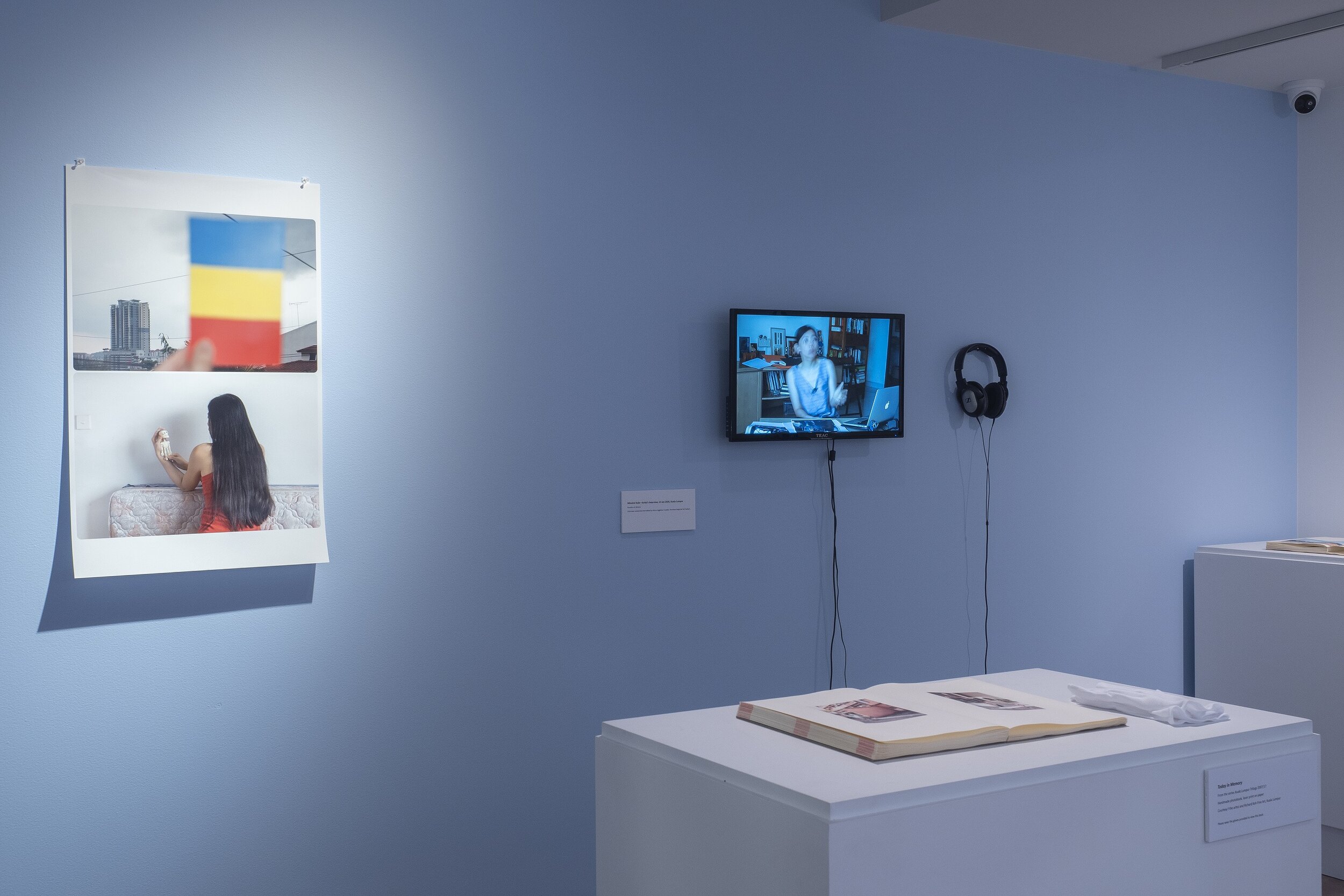Nati Frinj Biennale 2025 Festival Program Catalogue
Program website, logos and concepts created by Festival Director Alison Eggleton, in collaboration with Graphic designer Hannah French and support from GreenGraphics
go to for full online program and downloadable program catalogue: https://natifrinj.com/program/
She who has no self
Written by Alison Eggleton, Curator Horsham Regional Art Gallery, February 2020
Wrapping the cover of this catalogue is an image of She who has no self from Minstrel Kuik’s photographic installation. Framed by a series of overlapping circles, an Asian woman’s face appears, her hands to the corners of her eyes. She is just visible, appearing and disappearing in a shifting depth of field. Like a film reel, in a sequence of images, she slowly changes the position of her gesture. The woman is the artist performing for the camera, imitating a “Chinese woman”.
In this, as in many of Kuik’s works, she plays with the construction of the photographic image, its conception and perception, to question the periphery of cultural identity, conformity, gender and the politics of place. Interested in how the act of seeing is shaped by society, 1 Kuik explores photography’s equivocal relationship to truth, to understand the self amongst the complexities of modern life in Malaysia.
Within the complex digital montage of She who has no self, Kuik’s figure sits in tension with two interconnected relationships; family and nationhood. The image of a hibiscus flower, Kuik originally picked from her balcony then dried, appears skeletal in forensic detail. This Chinese botanical specimen, ironically the national flower of Malaysia and found growing abundantly in the Kampongs (Malay villages). Here it symbolizes the dual meaning of the flower as the individual’s vanity and cultural integration into the national narrative, linked by how one wishes to be seen. The image of the round mirror, reflects the malaise of the individual ‘s connection to national narratives, which is characterized by a constructed national identity that attempts to unify the multi ethic society with the broad brush stroke of one identity. 2
This major body of work originally made in 2014, is now reworked and retitled for this exhibition. The images are turned from a positive to a negative, from pink tones to black and white, the scale enlarged and the surface grainy. These recent manipulations reflect her process of making over time, as she rethinks material relations, and repositions the body and her culturally gendered experiences within these relationship dynamics.
The use of the word ‘self’ is carefully chosen. It surpasses the construction of the individual so well known in the west. The individual is one that is not separate from society, but governed by societal forces, in a triangle of drama, between family and nation. 3 Born in Malaysia of Chinese ancestry, Kuik negotiates these tension daily.
‘The non-Malays (Chinese), no matter how deep their family roots might go, are ... pendatang (recent immigrants) and only guests in Malaysia.’ 4
For Kuik ‘she’ not only references woman, it is a place, an object, a group of people or simply a state of mind. The title She who has no self, Kuik borrows from the Buddhist deity Nairatyma. Applied here poetically through the images of the artist’s figure, the flower and the mirror, the ‘self’ dissolves into a state of impermanence beyond the controls of society.
For Kuik ‘she’ not only references woman, it is a place, an object, a group of people or simply a state of mind. The title She who has no self, Kuik borrows from the Buddhist deity Nairatyma. Applied here poetically through the images of the artist’s figure, the flower and the mirror, the ‘self’ dissolves into a state of impermanence beyond the controls of society.
Printed on fabric and over 18 metres in length, the work internally wraps the physical space of the gallery, enclosing the viewer. Kuik’s installation makes reference to the fantastical Qing Dynasty novel, Flowers in the Mirror. As the mythical story suggest, She who as no self becomes a contemporary pavilion of mirrors, where the digital manipulation and layering of images reinforces the notion of a reality abound with perception and illusion.
In an early discussion with Kuik about truth, and truth in photography, she quoted philosopher Martin Heidegger, from the 1930 book On the Essence of Truth:
“Truth” is not a feature of correct propositions which are asserted of an “object” by a human “subject” and then are “valid” somewhere, in what sphere we know not. Rather, truth is disclosure of beings through which an openness essentially unfolds.
Kuik does not begin making work knowing the outcome, rather, embedded within the construction of her photographic images is an awareness of her surroundings, integral to place, and an understanding of the powerful role photography can play in representation and identity politics. This is a conscious response to the political messaging and photographic imagery of national unity amid the lived experience of racial inequality in Malaysia. Negotiating the tensions of different ideologies and social bounds is an everyday occurrence. Place based photographic practice grounds her image making 5 giving a sense of self to counter the State driven rhetoric promoting racial harmony. The photographic montage is one way Kuik addresses the constant slippage from reality in this master narrative.
Kuik’s approach to the medium of photography does not fit neatly into any one style or technique. 6 It is a tool from which she works with an openness, shifting between the vernacular and the performative; between the ‘snapshot’ documentary and highly constructed assemblage. This forms a distinctive repertory of images from which she works and reworks. Her extensive reading, thinking, making and revisiting is traceable and reflective through digital manipulation and text.
Through this photographic archive, the index 7 of time becomes a reoccurring point of dialogue. Kuik responds to each exhibition invitation as an opportunity to look into her archive, to rework images with the physical space of the gallery in mind. Transforming images into negatives is another way in which she traces time and personal history. Through the digital negative Kuik also connects to the materiality of the mid tone grey she explores in her drawing practice. The artist’s disruption of these records through the act of retitling and digital manipulation directly challenges the notion of truth while tracing her shifting concerns over time.
In this exhibition is also the series Mer.rly Mer.rly Mer.rly Mer.rly Part 1 & 2, a major body of photography shown for the first time in its entirety. Working from an archive of images over a decade, Kuik distinctively constructs 43 photographic pairs. Along the wall of the gallery is an image of young girls, triplets, perched on a couch above an image of pomegranate seeds held in the palm of the artist’s hand. On another wall an image of a mango hanging wrapped in plastic, above an image of women, one with a baby in her arms, greeting each other in the street. On another, a card of primary colours blue, yellow and red held at a window, sitting above the image of the artist’s long head of hair as she holds a miniature skeleton doll.
This series was first conceived from photographs Kuik shot on her return to Malaysia after 12 years spent overseas. At that time she preferred to pick up the camera than cook in the kitchen with the female members of her family. 8 In vivid colour, observations of everyday ritual and intergenerational bonds (her niece, her mother ) and surroundings of her village in Perak then extended to the broader urban spaces of Kuala Lumpur, the street, foreign workers and construction sites in the city.
A combination of documentary and still life compositions reveal sections of the artist’s body in the photographic frame as she balances the act of performing with the act of capturing the scene. Appearing at first as diary like snapshots of everyday life, they are imbued with metaphor; hair as an important female cultural currency, the mango a ubiquitous fruit to Malaysia, blood as female fertility, girl as childhood self, fish as the body, political leaders as the father and foreign worker as ‘other’.
With the camera’s view always looking out to the surroundings, we do not see her face nor is she pictured with family members, Kuik brings to our attention her absence from these images. It is in this rhythmic narrative of the public and the private, that the artist locates the proximity of our relationship to family and the family album while grappling with her own sense of belonging amongst the gendered realities of everyday life in Malaysia.
Inspired by philosophical discussion in ‘the everyday’ while studying in France, Kuik wanted to create the archetypical Chinese Malaysian family album. One that represented her ‘hometown’ 9 but as an adult self, she wondered if this was even possible. Through the aesthetics of the family album she questions the notion of loyalty in family, who she is as a women, daughter, aunty, sister and how she fits in.
Each work in Mer.rly Mer.rly Mer.rly Mer.rly Part 1 & 2 is titled, the words bridging the images in the photographic quasi-pair. Finding the status quo within the pairs reflects her philosophy of living; “an artist is never separate from society”10 family or nation. Kuik finds patterns in the power structure of the nation and within family which she explores through image making.11
Marking a similar period of time in her practice, the Kuala Lumpur Trilogy 2007-17, a series of 3 handmade photobooks (National Baby, Guest Room & Today in Memory), serve as an extension of her use of the photographic archive. Through photographic essay narratives and automatic writing she maps place and thought.
‘I was born a woman, female, l was born Chinese, l was born in Malaysia and in this body, my art practice explores these living conditions’.12
The exhibition begins and ends with the double images of Mimic la chinoise, which float on fabric in pale grey tones. Similar to the performative images embedded in the layering of She who has no self, the figures powerfully play with the masquerade, while taking her body to the limits of cultural conformity. In conversation with the artist in January 2020, Kuik admitted that until she moved overseas to France she was unaware of being ‘Chinese’ beyond the bounds of Malaysia. Originally made in 2004-05, while studying photography in France, Mimic la chinoise confronts Kuik’s own experience of ‘otherness’ under the Western male gaze.
The word mimic, is a direct references to Jeff Wall’s iconic photograph Mimic from 1982, in which a white man makes a slant-eye gesture at an Asian man. Kuik’s double image looks directly at her imaginary audience, bringing into focus the individual self while subverting the East-West binary.13 In this work, the artist postures the historically open ended appearance and disappearance of the gendered experience. It is a powerful reminder of how cultural conformity is still perpetuated through stereotypes and how they can sometimes play out in daily life.
Through the language of photography and image making Kuik reflects on the trajectory of her lived experience. Her process brings to our attention the construction of images and photography’s capacity to be a medium of record while questioning the act of seeing.
References:
1, 6, 11 & 13 Zhuang Wubin (2016) Photography in Southeast Asia, a Survey 2016, NUS Press pages 41-47
2 Eric C. Thompson(2007) Unsettling Absences: Urbanism in Rural Malaysia, NUS Press, page 21
4 James Chin (2009) The Malaysian Chinese Dilemma: The Never Ending Policy (NEP), page 174
5 From artist’s email conversation to Racheal Ciesla, Photo2020 16 December 2019
7 Melissa Miles(2016) Rephotography and the Era of Witness, photographies 9:1, page 51-69
3, 8, 9, 10 & 12 Artist’s interview with curator Alison Eggleton in her home in Kuala Lumpur, 13 January 2020.
The catalogue was published by Horsham Regional Art Gallery in 2020 to accompany the solo exhibition Minstrel Kuik: She who has no self which opened on 15 Feb 2020, as part of PHOTO 2020 International Festival of Photography program. The exhibition closed to the public on 23 March in line with the COVID19 pandemic restrictions.
Text © the authors and Horsham Regional Art Gallery. The views and opinion expressed in this catalogue are those of the authors.
This publication was made possible through the support of the Gordon Darling Foundation
ISBN: 978-0-9579962-5-0
Sue Pavlovich - Sensorium #1, March 24 - April 8, 2018
Exhibition review Written by Alison Eggleton as an Independent curator
Sensorium, an installation by artist Sue Pavlovich at The Goat Gallery, Natimuk, was an invitation to engage with soft sculptural objects that excite sensory perception and the corporeal body to act. Yellow, blue and red drops of cloth dominated the gallery space, hung from walls or rested horizontally on the floor. Recognizable as sack and cocoon-like objects, in an organised field familiar to early childhood experience of learning, the audience was invited to touch, play and explore the potential. Some works were instructed by cards or by the artist’s voice to facilitate this process. This was a call for movement with and within these objects, and for a stillness.
Pavlovich’s Sensorium springs from a long engagement with participatory art that began in childhood. Introduced to creative movement and poetry, in the 1970’s, she discovered the performance work of the Japanese Gutai movement, and Duino Elegies the seminal work of Bohemian-Austrian poet Rainer Maria Rilke. Around the same time, she participated in creative movement classes led by Australian performer and activist Benny Zable. Creative movement gave her a language, a launching point to interpret the world, which has driven her practise ever since. Pavlovich says, ‘The impulse at this end of my life is to lead participants in discovery, a version of Rilke's “tell them things”.
It’s no surprise, then, Pavlovich’s installation places the audience in the position of both observer and participant. To participate, by covering oneself in a cloth object, is to surrender part of the sensory apparatus of the body. In doing so, visual and audible perception is dramatically altered. Movement is limited while other senses such as touch are heightened. For Pavlovich, this altered awareness, familiar to early childhood play or meditative stillness, opens up states of reflectiveness, half-forgotten dreams or memory. A psychological space common to all of us. The investigation of the ‘sensorium’ is also informed by her experience teaching guided movement communication through kinaesthetic structures and non-verbal communication, several years earlier.
And while the use of primary colours is inspired by the body socks worn in the Endgame, a 1970’s Irish TV program she revisited in 2013, the bold colour code implies a gestalt meditation on proximity and connectedness. This relationship places the cocooned body in direct engagement with the social space of the gallery where sociality in all its forms is taking place. To the observer, the figure becomes ambiguous in gender, race or social context. Their identity witnessed from the position of observed shape, form, colours and gesture. Conversations that might flow easily become stilted, self-conscious or peeter out through sensory deprivation or altered states of concentration. Everyone present is directly or indirectly a participant of the Sensorium.
Pavlovich’s work opens up references to ‘slow sociality’, in its relationship between observer and participant through a subtle entanglement with art located in action. In leading the participant in discovery, she subvertly challenges the position of the artist and formal site of the gallery. Engagement and observation of the private and public self within a socially constructed space, based on Nicholas Bourriaud’s Relational Aesthetics, was the focus of Pavlovich’s Masters in Visual Arts, from Monash University 2012-14. The installation Sensorium embodies both uninhibited spirit of the ‘happening’ and a reflective stillness of movement. While Pavlovich considers herself a visual artist, it is clear her formative years have shaped the artist she is today.
Sue Pavlovich teaches art at Horsham College, Horsham Victoria.
This exhibition review was written for Art Education Australia, Vol 39, number 3, 2018, pp 494-495
https://www.arteducation.org.au/images/stories/files/journal-files/v39n3/AEA_V39_n3_exhibition_review_-_sensorium-1.pdf
Sue Pavlovich, Sensorium #1
Mixed media and interaction 2018
Photo Credit: Gabriel Jia
exhibition catalogue essay
In dialogue
Exhibition co-curators Alison Eggleton, curator Horsham Regional Art Gallery and Anthony Camm, director Ararat Regional Art Gallery, 2017.
Exhibition catalogue essay In dialogue written by Alison Eggleton was published by Horsham Regional Art Gallery, December 2017 to accompany Enmeshed: woven artworks from the Ararat Regional Art Gallery Collection, exhibition held at Horsham Regional Art Gallery, 15 December 2017- 4 March 2018
IBSN - 978-0-9579962-3-6
invited response
Shifting States (of awareness): Malaysia Australia Raft Project
Invited response written by Alison Eggleton, project artists 2016
In a clearing among tall eucalyptus and cypress trees a collection of tents and structures stand. As people gather a small village forms. I hear "All God's Beggars", and simultaneously witness the site, vibrating with meditative stillness, anxiety and resignation of the body. It is in this space where order and disorder, distance and proximity share the same continuum, that l notice the central structure of a raft. It sits marooned on the grass, as though a shrine to a monumental journey. I wondered where this vessel had come from, where it had travelled. Embedded with a kind of solidarity and exciting potential, it is charged with impermanence, vulnerability and an otherworldly uncertainty of going off course. Built from recycled cooking-oil containers, bamboo poles and canvas, I am reminded of the literary classic The Adventures of Huckleberry Finn, in which we are drawn into the world of two boy’s seeking freedom and finding a place where generosity and kindness come to fruition.
Later l would meet artist Soong Ro Ger (Roger) and hear of his raft journey in 2012 with fellow artist Andy Lim Kah Meng, in which they constructed a raft and travelled for ten days through the lakes system of the Royal Belum State Park in Perak, Malaysia, on an unauthorized journey.
With few tenets, Anthony Pelchen has tangentially brought the people that surround him on board the Malaysia Australia Raft Project. Witnessed as audience among the backdrop of Nati Frinj, in my home town of Natimuk in 2013 and as participant at MAPFest in the old city of Melaka, Malaysia in 2014 and again on the forecourt of Australian Centre of Art (ACCA) for Performing Mobilities, Melbourne, 2015, he has brought me along also. And l have come to the realisation that through a metaphysical accumulation of experience, MARP has become a vessel of souls. In exchanging energy, temporal and generous in nature, each act is a series of ethereal moments.
Immersed in the sounds of the old city from MARP’s St Paul’s hill site, Australian sheep calls rang out. Recorded at night in Western Victoria, their calls in the dark, and perhaps need for orientation, paradoxically call to the heavens. In accenting their dislocation, Pelchen’s recording awakened a sense of familiarity and longing in me for home (Australia). He describes MARP, ‘as a platform to enact shared vulnerability and the possibilities of generosity’. Against this ethereal backdrop, MARP evoked a sense of sadness and purpose, one that’s anchored in hope and justice for people moving from one country to another.
Anthony Pelchen’s work offers us an interminable number of responses that deserve to inhabit our minds for some time. It is a site of unexpected associations. And in the forecourt of the ACCA, against the monolithic structure of its rusted steel walls, he escalated the potential of MARP further. In the shadow of its authority, the remade raft with a crew of international artists occupied the relative emptiness of the site for a one day. In these surrounds Pelchen characteristically orientates himself within a world of ordered and disordered states, open to whoever may interact. Excited by the potential, once again l found myself arriving somewhere unexpected.
Written by Alison Eggleton, 2016, as invited response to MARP, which was performed in the forecourt of ACCA, Melbourne as part of VCA’s Performing Mobilities Fluid States, 2015. The essay appeared in the companion publication Performing Mobilities published RMIT University, School of Architecture & Design, July 2016, pp 84.


